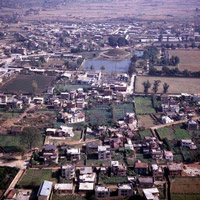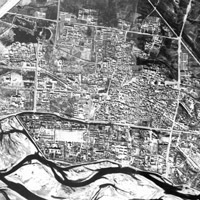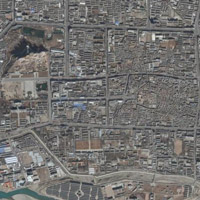
The Himalayan region


Urbanisation is defined as the percentage of total population living in settlements designated as urban areas.
Kathmandu is the capital of Nepal. Although Nepal was one of the least urbanised countries in the world, with only 6.3 percent of its total population residing in urban areas in 1981, it now seems that the 1971-81 decade experienced a major spurt in urban population, increasing by approximately 108 percent, at an annual rate of more than 8.4 percent. The urbanisation rate in the early 1990's was around 8 percent.
Nevertheless, only 23 settlements were designated as urban areas, and only one of these settlements had a population over 100,000 - the capital city of Kathmandu, which had a total population of slightly more than 235,000 inhabitants.
Together with the other two major urban settlements, Patan and Bhaktapur, the Kathmandu Valley in the Hill Region had the largest concentration of the total urban population - almost 40 percent.
Today, Nepal has the highest rate of urbanisation (5% per year) in South Asia. In Nepal, urbanisation is a recent trend that has taken place rapidly in an uncontrolled and haphazard manner. It has resulted in adding new issues to Nepal's environmental and developmental problems.
The problem is most severe in the Nepal cities that have to deal with increased amounts of solid waste generated by its expanding population, overcrowding, changing consumption patterns, use of new materials (like plastics), and increased industrialisation.
This has resulted in air and water pollution, health risks, and a general deterioration of the cities. 85% of Nepal's waste is solid waste, generated mainly by households, while waste from hospitals, agriculture (pesticides, fertilizer), and industries make up the rest. Hazardous waste is mainly disposed of with all other waste (dumping or incinerators) or stockpiled without adequate safety measures, thereby adding to the problems and risks of solid waste management.
 |
Urbanisation process in Kathmandu
|
Lhasa. Until the 1950’s, Lhasa was hardly affected by the dramatic global urbanisation processes cities and towns in many other western countries were experiencing.
Since 1959, the population of Lhasa has increased seven-fold. It grew from a small town with 30,000 inhabitants to 223,000 inhabitants in 2000. Along with the increase in the total number of inhabitants, the area also increased from 3 to 51 sq km.
Since the early 1990's, big parts of the old city have been redeveloped, and many historical buildings have been replaced by modern housing blocks.
 |
Lhasa 1965 (Corona)
|
 |
Lhasa 2005
|
Last update: 18 April 2013

 |  | 
Himalayas

| | • | Environmental problems in the Himalayas (http://www.esa.int/SPECIALS/Eduspace_Global_EN/SEMPKP0SAKF_0.html) |  | | • | Urbanisation (http://www.esa.int/SPECIALS/Eduspace_Global_EN/SEMQLP0SAKF_0.html) |  | | • | Mountain ecosystems (http://www.esa.int/SPECIALS/Eduspace_Global_EN/SEMKZP0SAKF_0.html) |  | | • | Nepal area (http://www.esa.int/SPECIALS/Eduspace_Global_EN/SEMP7Q0SAKF_0.html) |  | | • | Tibet area (http://www.esa.int/SPECIALS/Eduspace_Global_EN/SEMMDQ0SAKF_0.html) |  | 
Exercises

| | • | Himalaya - Worksheet (http://www.esa.int/SPECIALS/Eduspace_Global_EN/SEM4IQ0SAKF_0_ov.html) |  | | • | Landscape units of Nepal (http://www.esa.int/SPECIALS/Eduspace_Global_EN/SEMXJQ0SAKF_0.html) |  | | • | Urbanisation – 40 years of urban development of Lhasa (http://www.esa.int/SPECIALS/Eduspace_Global_EN/SEM5XQ0SAKF_0.html) |  | | • | Urbanisation – Detection by means of delineation of the city perimeter (http://www.esa.int/SPECIALS/Eduspace_Global_EN/SEM8DR0SAKF_0.html) |  | | • | Landslide detection in Langtang Himal (http://www.esa.int/SPECIALS/Eduspace_Global_EN/SEM0RR0SAKF_0.html) |  | 
Links

| | • | Further Reading (http://www.esa.int/SPECIALS/Eduspace_Global_EN/SEMW3S0SAKF_0.html) |  | 
Eduspace - Software

| | • | LEOWorks 3 (http://esamultimedia.esa.int/multimedia/LEOWorks3.exe) |  | 
Eduspace - Download

| | • | Himalayas_env1.zip (http://esamultimedia.esa.int/docs/eduspace/Himalayas_env1.zip) |  | | • | Himalayas_env2.zip (http://esamultimedia.esa.int/docs/eduspace/Himalayas_env2.zip) |  | | • | Himalayas_env3.zip (http://esamultimedia.esa.int/docs/eduspace/Himalayas_env3.zip) |  | | • | Himalayas_env4.zip (http://esamultimedia.esa.int/docs/eduspace/Himalayas_env4.zip) |  |

|

